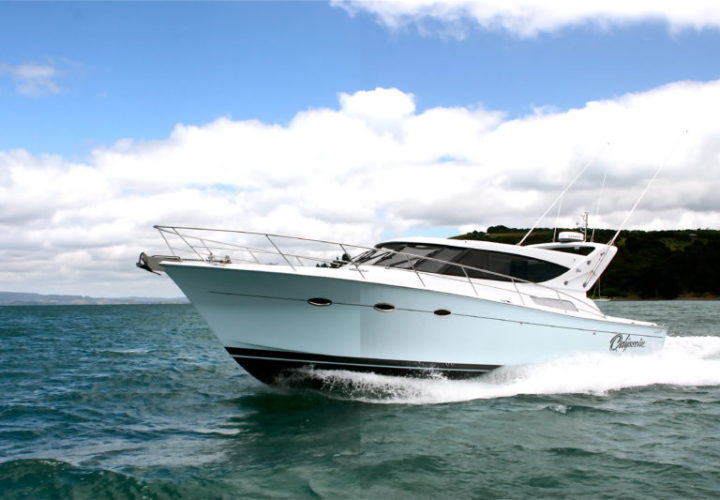Since 2001, Clevedon boatbuilder Scott Lane has built eight Elite cruisers, working with designer Bill Upfold and his clients to create unique vessels that, while they all have quite a lot in common, are also very individual.
His latest creation, the 13-metre sedan Odysseia, is slightly different. In this case the client is himself, his wife Letitia and his young family.
“All of my boats are essentially custom designs,” says Bill, “and Odysseia is no different. It is full of unique features that Scott and Letitia came up with and which I was happy to incorporate into the design.”
Custom Creations
The first of these is the tongue-in-cheek-named “God Step”. Initially looking like a traditional live bait locker, it is in fact a central section of the boarding platform that hinges outwards to create a two-step boarding ladder. As Scott proudly demonstrates, when one stands on the just-submerged bottom step it looks as though one is standing on water, hence the name. Another slightly different feature is the positioning of a rod locker and a throttle and thruster control in the starboard forward quarter of the cockpit, where one might expect to find a day head instead. As the vast majority of their cruising will be done with their family, Scott and Letitia obviously saw little need for a separate day head and therefore chose to use this valuable space more wisely.

Another cockpit innovation is the use of the space beneath the port bench seat as a well-insulated chilly bin cum icebox. Ideal for additional cold drinks (especially when the main fridge is full of other things like food) or for salt ice on a fishing trip, the area cleanly drains out under the platform without impinging on the cockpit.
Another of Scott’s clever ideas is the fitting of an engine room access door in the shower stall. This allows Scott to access the engine room (and a handy utility room) without the inconvenience of lifting hatches in the saloon or having to raise the companionway stairs.
As he explains, on previous boats, which used the raised stairs for access, once the stairs were up, access to the front part of the vessel (the cabins and head) was no longer possible.
“In the usual Murphy’s Law way, as soon as I was stuck in the engine room, someone else would need to go forward…”
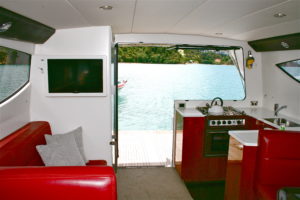
In another adaptation, Odysseia sports an in-built Fisher & Paykel household fridge/freezer, complete with a stainless steel finish and chilled water and ice dispensers in the doors. Sited just inside the bi-fold saloon doors, it is handy to both the U-shaped galley opposite and to the cockpit and, as Scott is keen to point out, boasts a huge amount of space.
Those familiar with Bill’s designs will also notice that the exterior styling is slightly different from that on many Elite cruisers. Unashamedly influenced by Zinfandel (the previous Elite built by Scott), Odysseia features attractively swept back windows and a low profile arch, giving it a racy, sporty look, even at anchor.
Single Engine
Odysseia also differs from many other sedan cruisers of this size by having just the single engine. Scott says this was part of his “keep it as simple as possible” philosophy, aimed at making the vessel as low maintenance and as inexpensive to keep going as possible.
He has therefore chosen to fit a single 455hp Caterpillar C7 diesel, complemented with fore and aft Max Power thrusters. This makes Odysseia very easy to manoeuvre in tight places, such as busy marinas, and gives a cruising speed of around 20 knots in all but the roughest of conditions.
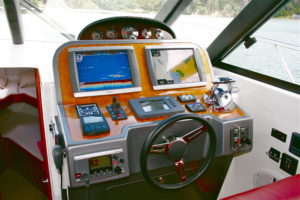
The C7 also gives a remarkably consistent fuel consumption of three litres per nautical mile, almost completely regardless of throttle setting. With a 1200-litre fuel capacity, this means Odysseia can comfortably cruise at around 20 knots for a good 400 nautical miles before needing to be topped up.
During our test run out of Pine Harbour on an (unfortunately) typically blustery Auckland summer’s day, Odysseia’s 11-odd metres of waterline coped admirably with both the downwind and upwind chop. The Elite sedan also moved easily from idle to on the plane with no noticeable hump to overcome and with no need to move the trim tabs from their midway point. According to Scott (who spent some 144 hours cruising on her over the Xmas/New Year holidays, and covered some 600 nautical miles doing so), Odysseia will happily plane at just 10 knots should conditions require it.
Low speed manoeuvring, such as when looking for a good spot to anchor, is also very easy, with virtually no weight on the helm. Odysseia also comes around very quickly, rather like a large powerboat, and during our mooching around I saw no need to use either the bow or stern thrusters.
She also handles like a large powerboat when turning at higher speeds, although there is quite a noticeable difference in the effort required. Scott chose a sporty steering wheel, which is possibly a bit small in diameter for the system as the weight on the helm increases at higher speeds.
A larger diameter wheel would rectify this or, alternatively, upgrading to power-assisted steering (although the latter comes at a cost and does add a level of complexity, which is what Scott has been keen to avoid).
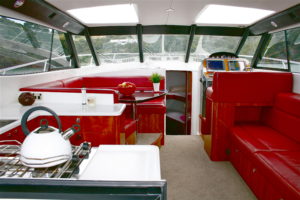
Unlike many boats of this size, especially flybridge models, Odysseia seems to require very little in the way of trim tab adjustment. If one is trying to see how fast she can run with the throttle pushed fully forward, it is helpful to raise the bow a bit but even then the resulting increase in speed is relatively minor.
There also seems little need to adjust for port and starboard trim, Odysseia’s low profile meaning she is hardly affected even in a strong crosswind.
Spacious cockpit
One of the reason’s Scott chose to site his novel “God step” into the boarding platform is that Odysseia’s normal home in the relatively shallow and very muddy Clevedon River effectively rules out positioning a live bait tank there (it would simply fill up with mud and silt and require constant cleaning).
He has therefore placed this on the starboard side of the transom and complemented it on port with a sink complete with handy pull-out hot and cold water shower.
With the single engine positioned under the saloon, the area under the cockpit sole becomes a large stowage hold with access via large twin hatches, supported by gas struts. The area is also home to the centrally mounted 1200-litre fuel tank and has been attractively finished in what Scott describes as “Pirelli-style” Noramatt anti-skid.
With the exception of the integral consoles and fore and aft bench seats forward, the cockpit is completely free of clutter, making it ideal for fishing, watersports or entertaining. A large centrally-positioned floor mounting can accommodate either a game chair or a cockpit table and a detachable awning (connecting to stainless steel supports that slot into the aft rod holders) provides protection from the sun or light rain when required.
The forward port console is, as usual, home to the barbecue (in this case, a single grill plate Plancha). However, where a freezer would normally occupy the space next to it, Scott has instead used this to house the gas bottle and fenders. As he explains, the combination of the large household fridge/freezer in the galley and the under-seat ice chest in the cockpit means there is no real need for another big fridge or freezer unit.
Another practical feature of this console is the inclusion of a brace of water outlets (one fresh, the other salt) beneath the barbecue. These make it very easy to clean up after a messy fishing session and at the conclusion of the cruise (the 1000-litre fresh water capacity helps, too).
Easy Flow Through
Good sedan design is all about having as little separation as possible between the saloon and cockpit areas and that is certainly the case on Odysseia. The back of the saloon is almost equally divided in two with a bi-fold door to starboard and a large hinge-up window over the galley to port. With both fully open, there is very little division between the two living areas. People can easily move back and forth through the large open doors and, equally easily, food and dishes can be transferred effortlessly between the galley and those in the cockpit.

Odysseia’s galley is a compact U-shaped one, meaning it is easy to work even in a seaway. The Force 10 oven and stove, flanked by practical bench space, faces aft, meaning steam and the like is easily vented into the cockpit. The sink is to port and there are plenty of practical bench and stowage options.
The saloon design is also practically simple: there is a raised dinette in front of the galley on port and a large bench seat connects the fridge/freezer housing and the helm on starboard.
The dinette, purposely high enough that people seated there can see outside when underway, easily accommodated Scott’s family of five on the summer cruise and the table features a drop-down support that he intends to modify so that the area can convert into another double berth if required.
Both the dinette seating and the saloon have been upholstered in a striking red leather which, attractive as it is, was not the Lanes’ first choice. As Scott explains, he and Letitia originally wanted a more distressed look (“like you would find on an old Jag”) but discovered that it was unlikely to wear well, especially in a mar
ine environment.
It is clear that they are not too disappointed: the red leather works really well and is nicely complemented by black snakeskin-patterned leather fascias high on the side bulkheads; these house the saloon lights and some of the speakers. The dinette table, made from black wenge timber, also goes well with the red leather.
There are lots of other nice touches throughout the saloon, too. The starboard settee, for example, has a wee “cave” at its for’ard end (basically the space under the helm seat) which means those over 1.8 metres tall can fully stretch out, creating another comfortable berth if needed.
There are pull-out drawers under both the dinette and the settee and the forward-most one of these on the port side is what we once, in less politically correct times, would have called the grog locker. It comfortably accommodates 12 wine bottles and a further five of spirits, all standing vertically and within easy reach.
The saloon also features a hinged flat screen TV on the bulkhead at the aft end of the settee. It lies flat against the bulkhead when not in use and easily swings out when required so that it can be seen by those seated at the dinette.
Odysseia’s helm is a compact and attractive affair with American cherry set into gun-metal grey surrounds and topped off with an eyebrow of Wenge. This latter houses the Caterpillar’s analogue instrument dials and, as Scott explains, is not really needed. All the information these dials deliver could instead be displayed on the CAT MFD panel.
However, like many of us, Scott simply feels more comfortable looking at the traditionally round analogue displays.
He is also full of praise for the Garmin system, which he says was very easy to master. Its twin 12-inch screens occupy the top half of the dash and, in addition to showing the traditional digital charts, fishfinder and the like, also, when required, display the live feed from a camera in the engine room. While this might seem a bit gimmicky to some, it proved eminently practical, as we discovered shortly after leaving the marina.
As we passed a launch on its way into Pine Harbour a strong smell of burning plastic became noticeable. Slowing down, we were able to use this live feed to quickly check that Odysseia’s engine room was free of smoke. We were therefore able to deduce that the smell was coming from the other boat – far easier than having to leave the helm and head down to the engine room to check it out.
The lower, flatter, section of the dash contains that CAT panel, an AA560 Auto Anchor control (for the Lofrans windlass), the main Max Power thruster controls, a panel for the MarinCo searchlight, the beautifully chromed ZF controls (which look as though they operate two engines when there is, of course, only one) and the QL trim tab panel.
The front of the dash is home to the Garmin VHF radio, while the Fusion stereo system is over on the side, meaning it can be operated by anyone on board without disturbing the skipper.
On the side bulkhead, conveniently close to the skipper, are the Dometic Tank Monitor and the controls for the holding tank, the windscreen demister and the Webasto diesel heater.
This latter is a wonderful addition to the boat and, in our relatively temperate climate, probably far more useful that an air conditioning system, especially on a sedan-style boat such as Odysseia, that has twin opening sun roofs.
When in use, the heater quickly demists the screen and, with well-positioned outlets throughout, effectively heats the entire vessel.
Odysseia’s windscreen is divided into three panels and there is an individually controlled wiper and washer for each.
Practical accommodation

Because there is considerably less natural light in the forward section of the vessel, Scott and Letitia have used a reflective white ridged wallpaper on the bulkheads in the companionway and the two cabins. With three children, Scott and Letitia have decided to position their own accommodation to port and use the bow cabin for the children.
The master cabin is a relatively simple affair with a forward-facing berth against the aft bulkhead and a drawer console at its foot. This latter matches American cherry drawer fascias with a black wenge flat area on top. There are two opening portholes and a relatively small hatch for ventilation.
The “kids cabin” has a double berth to port above a cupboard and drawer unit, and a small single above a larger one to starboard.
Scott and Letitia have chosen to forego the convenience of an ensuite and instead sited their head/shower room to starboard. Again, the design here is one of practical simplicity with the Dometic head against the forward bulkhead, mirrored doors on the substantial bulkhead cupboard and a separate shower stall, complete with a moulded seat, shower holder and its own door. They have also installed a stainless steel double rail close to the side bulkhead and this proves the ideal place to hang wet suits etc while they dry.
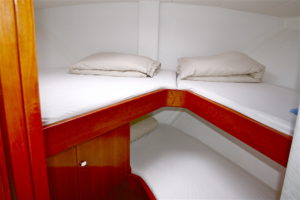
The shower stall is also home to that engine room door, an attractive SeaMac aluminium model that opens into a handy utility room. Complete with shelves on both sides it is used to store the ship’s towels, vacuum cleaner and sundry other items (such as spare cartons of beer) until they are needed.
The engine room itself is, as one would expect on a boatbuilder’s own vessel, incredibly neat and tidy, with plenty of room for any of the servicing that needs to be undertaken.
Conclusion
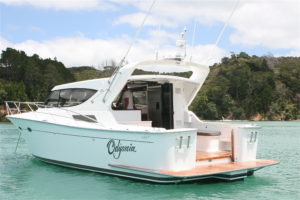
The fact that the Lanes put Odysseia into the water on 21 November last and went boating that night speaks volumes, both for Bill’s meticulous design and for Scott’s boatbuilding prowess. So does the fact that they then cruised north as far as Cape Karikari and Matai Bay and returned, after about 600 nautical miles and 144 engine hours, with nothing more troubling than a sticky trim tab. Odysseia is Bill Upfold’s 61st boat to hit the water and the 8th Elite that Scott Lane has built. That experience, and the fact both are keen boaters as well, shows in every square millimetre of this, their latest enviable creation.


